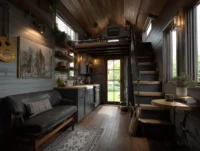Creating a home that’s stylish yet accommodating for our furry friends can feel like a challenge, but it doesn’t have to be. With a bit of creativity and thoughtful planning, we can design spaces that cater to both our pets’ needs and our personal style. A pet-friendly home isn’t just about functionality—it’s about blending comfort, durability, and aesthetics seamlessly.
Understanding Pet Friendly Interior Design
Pet-friendly interior design focuses on creating spaces that cater to the needs of pets while maintaining aesthetic appeal. Durable, safe, and easy-to-clean materials are key. These elements improve functionality without compromising style.
Flooring choices significantly impact a pet-friendly home. Materials like tile, vinyl, or laminate resist scratches and stains, unlike hardwood or carpet. These options simplify cleaning and offer better longevity.
Furniture selection involves considering sturdy fabrics and frames. Microfiber, leather, or outdoor-grade fabric resists wear from claws or fur and is more resistant to stains. Selecting furniture with washable covers offers added convenience.
Incorporating pet-specific spaces enhances comfort and organization. Built-in feeding stations, discreet litter box enclosures, or cozy nooks for resting help integrate pet essentials into your home’s design.
Non-toxic materials and finishes are essential for pets’ safety. Sealants, paints, and finishes labeled pet-safe reduce exposure to harmful chemicals, safeguarding their well-being.
Effective storage solutions help maintain an organized space. Cabinets or bins for toys, leashes, and grooming supplies keep clutter minimal and accessible.
Lighting and layout adjustments accommodate pets’ behaviors and preferences. Open spaces allow free movement, while natural light benefits both pets and humans.

Choosing Pet Friendly Materials
Selecting appropriate materials improves the durability and functionality of a pet-friendly home while maintaining its aesthetic appeal. Using scratch-resistant, easy-to-clean, and safe materials reduces stress and enhances everyday living.
Flooring Options
Flooring impacts both appearance and practicality in a pet-friendly environment. Hard surfaces like porcelain tile, luxury vinyl, and laminate are ideal for resisting scratches and stains. For example, vinyl is water-resistant and easy to maintain, making it suitable for areas pets frequent. Opting for sealed concrete works well for durability and a modern look.
If softer floors are preferred, low-pile carpets are better at trapping less pet fur and are easier to clean than high-pile options. Invest in stain-resistant treatments to protect the material from pet-related accidents.
Furniture Fabrics
Durable fabrics prevent wear-and-tear caused by pets. Microfiber and synthetic leather resist scratches and are simple to clean. Microfiber is also stain-resistant and comfortable, blending functionality with style. Consider genuine leather for durability against minor damage, although it may show visible aging over time.
Slipcovers provide additional protection and are convenient for machine washing. Patterned or textured fabrics, like tweed, can also help conceal fur or minor stains, making maintenance easier.

Designing Spaces For Your Pets
Creating dedicated spaces for pets improves functionality and ensures their comfort in a shared living environment. Thoughtful design can integrate these spaces seamlessly into home interiors.
Cozy Corners And Beds
Designating cozy corners or beds offers pets a comfortable retreat. Adding soft cushions, orthopedic mattresses, or memory foam bedding supports pets’ physical needs while enhancing coziness. Place these areas in low-traffic zones, ensuring tranquility. Use washable covers in neutral or patterned fabrics, enabling easy maintenance and blending with the existing decor.
In small spaces, corner beds or multipurpose furniture like built-in storage benches with padded tops optimize the layout. Elevated beds work well for maintaining cleanliness while keeping pets off main furniture. When selecting, prioritize non-toxic materials and stain-resistant fabrics.
Built-In Feeding Stations
Incorporating built-in feeding stations enhances organization and minimizes clutter. These stations can integrate into cabinetry, kitchen islands, or under counters, keeping bowls secure and preventing spills. Consider retractable drawers or pull-out platforms to discreetly store food and water bowls when not in use.
Choose bowl materials like stainless steel or ceramic, which are hygienic and durable. Add a non-slip mat underneath to reduce movement and protect flooring. Placement matters—near water access or a low-activity area promotes ease of use while creating a functional dining spot for pets.

Practical Ideas For Cleaning And Maintenance
Cleaning and maintaining a pet-friendly home is simpler with the right design choices. Durable, easy-to-clean materials and thoughtful features help minimize mess and upkeep.
Stain-Resistant Options
Choosing stain-resistant materials prevents permanent damage from spills or accidents. For upholstery, synthetic fabrics like microfiber and crypton repel liquids and reduce staining, making them ideal for sofas or chairs. For rugs, indoor-outdoor options or those made from polypropylene resist pet-related stains and are easy to clean. Wall paints with washable or satin finishes add a layer of protection, allowing quick removal of marks or grime.
Easy-To-Clean Surfaces
Incorporating easy-to-clean surfaces ensures efficiency in handling regular messes. Waterproof flooring like tile, luxury vinyl, and laminate provides resistance to dirt, scratches, and moisture, streamlining cleanup. Smooth countertops in materials like quartz resist scratches and stains while being wipeable. Avoid high-gloss finishes on floors or cabinets as they tend to show paw prints and smudges more prominently, making matte or textured options preferable.

Adding Style Without Compromising Functionality
In pet-friendly interiors, style and practicality can coexist. By incorporating thoughtful decorative elements and strategic color choices, we create spaces that cater to both aesthetics and functionality.
Pet-Safe Decorative Elements
Decorative pieces should enhance design without posing risks to pets. We recommend using materials like ceramic, wood, or metal for accessories, as these are durable and non-toxic. Avoid fragile items such as glass vases in low areas, where pets can knock them over, and opt for weighted or securely placed décor. Indoor plants like spider plants or ferns add life to a room, but it’s crucial to avoid toxic varieties like philodendrons or lilies. Wall-mounted art and non-toxic paints can bring style without disrupting pet-friendly zones.
Color Schemes That Hide Fur
Color choices can minimize the visibility of pet fur. For homes with light-colored pets, soft grays, beige, or cream tones on furniture and fabrics work well. For darker-coated pets, deeper hues like charcoal, navy, or brown help conceal shedding. Patterns such as subtle stripes or mottled textures also hide fur effectively while adding visual interest. Use washable slipcovers or stain-resistant finishes to maintain style while ensuring cleanup remains manageable.
Conclusion
Practical pet-friendly interior design is achievable with thoughtful planning and intentional choices. By prioritizing durable and easy-to-clean materials, we ensure our spaces can withstand pets’ activities while maintaining aesthetic appeal. Incorporating cozy pet-specific areas like built-in feeding stations or resting nooks enhances functionality and comfort.
Safety remains crucial, which is why non-toxic finishes, secure storage, and pet-safe plants are essential. Practical solutions like stain-resistant fabrics and waterproof surfaces simplify cleanup, making daily maintenance efficient. Additionally, using color schemes and patterns that complement pet fur helps balance style and practicality.
With these strategies, our homes become harmonious environments where pets and owners coexist comfortably, without compromising design preferences.















Leave a comment